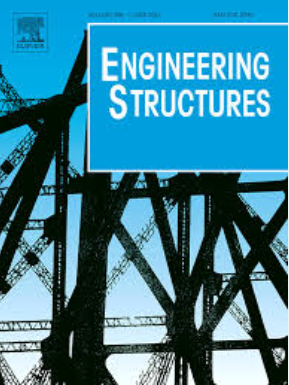BFRP-RC梁在弯曲-剪切-扭转复合荷载作用下的尺寸效应试验研究
IF 6.4
1区 工程技术
Q1 ENGINEERING, CIVIL
引用次数: 0
摘要
研究了构件尺寸和扭弯比对BFRP-RC梁在扭弯剪组合荷载作用下的力学性能和尺寸效应的影响。对15根不同扭弯比和构件尺寸的BFRP-RC梁进行了试验。试验结果表明,扭弯比对试件的抗扭、抗剪性能均有影响。剪力的存在会改变梁的破坏模式,降低梁的抗扭承载力、延性和变形能力。随着剪切比的增加,这种效应变得更加明显。复合荷载作用下,BFRP-RC梁的强度、延性和变形能力表现出显著的尺寸效应。当梁高从300 mm增加到900 mm时,抗扭强度和抗剪强度分别降低39.80 %和42.12 %。随着扭弯比的增大,尺寸对抗扭、抗剪强度的影响先增强后减弱,其临界扭弯比为0.6。根据试验结果,对现行设计规范的合理性进行了评价。验证了所建立的玄武岩纤维增强聚合物棒钢筋混凝土(BFRP-RC)组合梁的尺寸效应模型,可以准确预测其承载力。本文章由计算机程序翻译,如有差异,请以英文原文为准。
Experimental investigation of size effects on BFRP-RC beams under combined bending-shear-torsion loading
This study investigated the influence of the member size and torsion-bending ratio on the mechanical property and size effect of BFRP-RC beams under combined torsion-bending-shear loadings. Fifteen BFRP-RC beams with varying torsion-bending ratios and member sizes were tested. The test results show that the specimens' torsional and shear performance can be affected by the torsion-bending ratio. The presence of shear would alter the beams' failure mode and reduce the beams' torsional carrying capacity, ductility, and deformation capacity. This effect becomes more pronounced as the shear ratio increases. Under the combined loadings, the strength, ductility, and deformation capacity of BFRP-RC beams exhibit remarkable size effects. As the beam height enlarges from 300 mm to 900 mm, the torsional and shear strengths can decrease by up to 39.80 % and 42.12 %, respectively. As the torsion-bending ratio increases, the influence of size on torsional and shear strength first strengthens and then weekends, and the critical torsion-bending ratio is 0.6. Furthermore, the rationality of the current design codes was remarked based on the experimental results. The proposed size effect model for Basalt Fiber Reinforced Polymer Bars Reinforced Concrete (BFRP-RC) beams under combined loading was validated to predict their bearing capacities accurately.
求助全文
通过发布文献求助,成功后即可免费获取论文全文。
去求助
来源期刊

Engineering Structures
工程技术-工程:土木
CiteScore
10.20
自引率
14.50%
发文量
1385
审稿时长
67 days
期刊介绍:
Engineering Structures provides a forum for a broad blend of scientific and technical papers to reflect the evolving needs of the structural engineering and structural mechanics communities. Particularly welcome are contributions dealing with applications of structural engineering and mechanics principles in all areas of technology. The journal aspires to a broad and integrated coverage of the effects of dynamic loadings and of the modelling techniques whereby the structural response to these loadings may be computed.
The scope of Engineering Structures encompasses, but is not restricted to, the following areas: infrastructure engineering; earthquake engineering; structure-fluid-soil interaction; wind engineering; fire engineering; blast engineering; structural reliability/stability; life assessment/integrity; structural health monitoring; multi-hazard engineering; structural dynamics; optimization; expert systems; experimental modelling; performance-based design; multiscale analysis; value engineering.
Topics of interest include: tall buildings; innovative structures; environmentally responsive structures; bridges; stadiums; commercial and public buildings; transmission towers; television and telecommunication masts; foldable structures; cooling towers; plates and shells; suspension structures; protective structures; smart structures; nuclear reactors; dams; pressure vessels; pipelines; tunnels.
Engineering Structures also publishes review articles, short communications and discussions, book reviews, and a diary on international events related to any aspect of structural engineering.
 求助内容:
求助内容: 应助结果提醒方式:
应助结果提醒方式:


